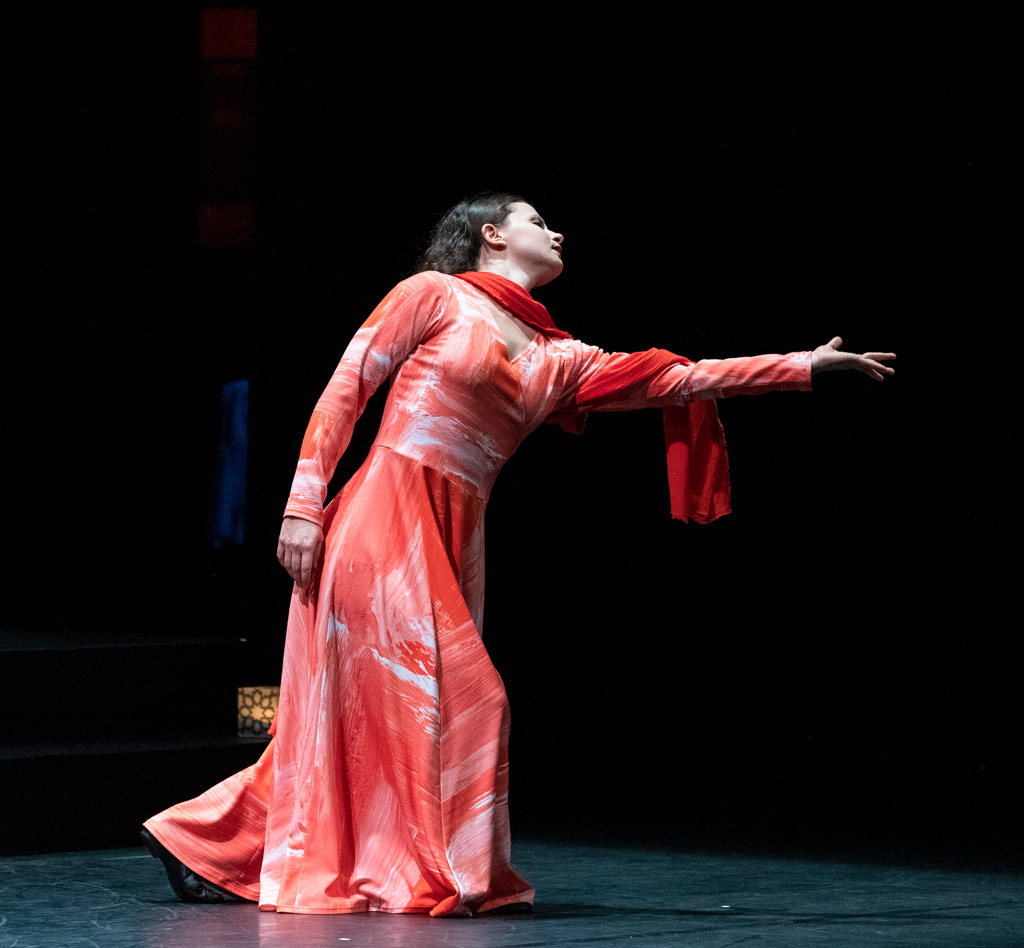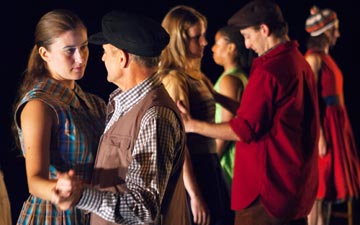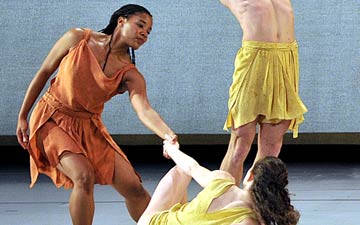
© Foteini Christofilopoulou. (Click image for larger version)
Mark Morris Dance Group / Silkroad Ensemble
Layla and Majnun
★★★✰✰
London, Sadler’s Wells
13 November 2017
Gallery of pictures by Foteini Christofilopoulou
laylaandmajnun.org
markmorrisdancegroup.org
www.silkroad.org
www.sadlerswells.com
Mark Morris’s Layla and Majnun is a music concert with dancing, lamenting a love that cannot be. It’s an age-old story, spread across continents and centuries. Morris and the cellist Yo-Yo Ma, founder of the Silkroad Ensemble, opted to set it to Azerbaijani music and lyrics, based on an opera composed in 1908. If you want to know more about Uzeyir Hajibeyli’s opera, Azerbaijani folk music and the Silkroad Ensemble’s ‘cultural synthesis’ arrangements, the Sadler’s Wells programme is a fount of information, along with a website about the story, laylaandmajnun.org.
In performance, the result is rather like a flamenco tablao – a place where musicians and dancers share parity and the singers’ heartfelt wailing is largely unintelligible. Everyone is suffering deep-seated emotions but it’s impossible to know why, exactly. You have to accept that love, like life, can be cruel; artistry lies in the performers’ expression of impersonal anguish.

© Foteini Christofilopoulou. (Click image for larger version)
Layla and Majnun starts with a sad song and grows successively sadder, ending with the lovers’ death (unless they are united in the hereafter). The opening medley, which lasts for some 10 to 15 minutes, apparently features three vocal genres of traditional music from Azerbaijan, setting the scene for the danced opera that follows. Each scene is captioned on video monitors to the sides of the stage, and the lyrics are provided in the programme – though quite why the lovers can never be together remains a mystery.
The two singers are a national treasure of Azerbaijan, Alim Qasimov, and his daughter, Fargana Qasimova. They sit centre stage, surrounded by 10 musicians on western and eastern instruments. Dancers move around them on different levels, taking it in turns to represent Layla and Majnun and their parents. They also serve as a chorus of witnesses of the doomed love affair. Their silken garments are luscious, complementing the vibrant colours of Howard Hodgkin’s backdrop, painted a year before his death in 2017. James Ingalls’s lighting changes the relationships of the colours in each scene.

© Foteini Christofilopoulou. (Click image for larger version)
Of the four Laylas, those with long hair echo Hodgkin’s brushstrokes as they toss their heads and whirl in dervish spins. Their hearts are already broken when the first Layla and Majnun appear, Mica Bernas and Dallas McMurray, distinguished by the long colour-coded scarves around their necks. They gaze at each other adoringly, but touch no more than their fingers. The chorus dances around them enthusiastically in folksy steps until everyone is subdued by the disapproval of the young lovers’ parents.
The mothers are very short (Lauren Grant and Christina Sahaida), the fathers very tall (Noah Vinson and Billy Smith). The vocal music is full of reproach and defiance as the lovers plead with their parents. Isolated on a plinth at the back, a new Majnun (Domingo Estrada) plunges forward towards Layla (Nicole Sabella) in arabesque, as she mirrors him in reverse, folding her extended leg inwards. He rushes around in a frenzy, possessed by his obsession with Layla.
She is obliged to marry a man her parents have chosen for her. The dancing becomes very stylised, the chorus splitting into same-sex groups or joining in formal processions, with hints of Nijinska’s Les Noces. They break into a kind of Balkan folk dance during the wedding celebrations, while Majnun deplores Layla’s unfaithfulness and attacks her husband (Durrell R. Comedy). There is no chance of sympathy for the husband in this doomed romance.

© Foteini Christofilopoulou. (Click image for larger version)
For the last scene, ‘The Lovers’ Demise’, the dancers sit among the musicians, either listening or performing an upper-body ballet, heads thrown back in despair. Each of the four Laylas has a solo of suffering, twisting and turning to the singers’ cries of agony, until they are joined by the four Majnuns, ready to die for love. After all the pairs have sacrificed themselves for their beloveds, they process in two lines, caressing each other briefly in parting. The two mothers mournfully extinguish the last candles on the empty stage.
Though the dancing makes the music visible, Morris’s choreography doesn’t match the intensity of the plangent, throaty voices (or the printed lyrics in the programme). Maybe there is a problem in the improvisational nature of the music, resulting in the dancers listening and responding rather than conveying their own passion. The flames of desire blaze on Hodgkin’s backdrop, not on the dance floor. It makes for a subdued theatrical experience, unless you are carried away by Azerbaijani operatic and traditional music, adapted for Western ears.

















You must be logged in to post a comment.